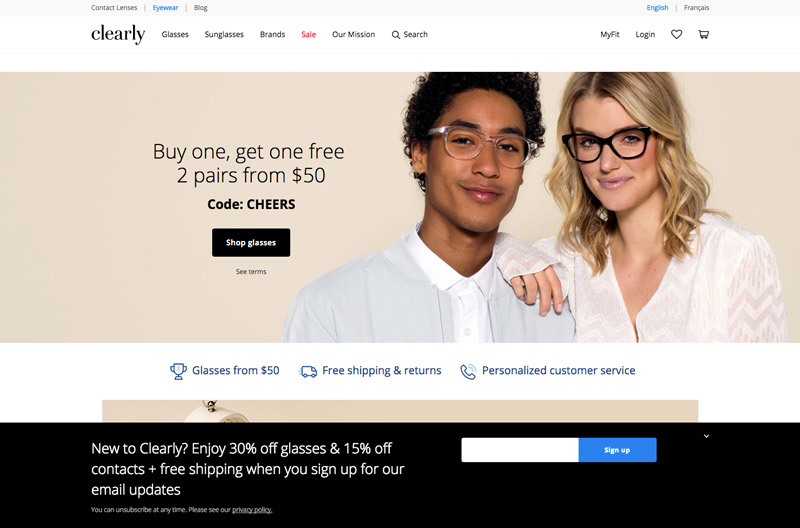If you’ve had a chance to implement a few of the tips in our various ecommerce articles, you’re well on your way to ecommerce success.
By now, you’re probably an expert at getting people in the door – but how do you get them to pick up a couple of items before they leave?
I’m going to give you seven proven strategies to convert your ecommerce website traffic. I guarantee these tips will help you sell more, add more emails to your subscriber list, and generate more long-term customers.
Let’s jump into it.
1. Incentivize first-time visitors with a coupon code
When it comes to ecommerce, first-time visitors are crucial.
Why? First-time visitors are the visitors you work the hardest – and pay the most – for. They’re often not very familiar with your business, meaning it’s imperative you put your best foot forward when dealing with them.
In this case, that best foot should look something like this:

Entry overlays run rampant in ecommerce, and with good reason. It’s like having a greeter at your retail store – they give your visitors a warm welcome to your website and often incentivize them to make their first purchases.
In my experience, the most effective welcome offer is a coupon code, offering a specific discount on the products in your store. Offer a flat or percentage amount, and make sure you make it feel both exclusive and limited in time to minimize the number of people who bounce.
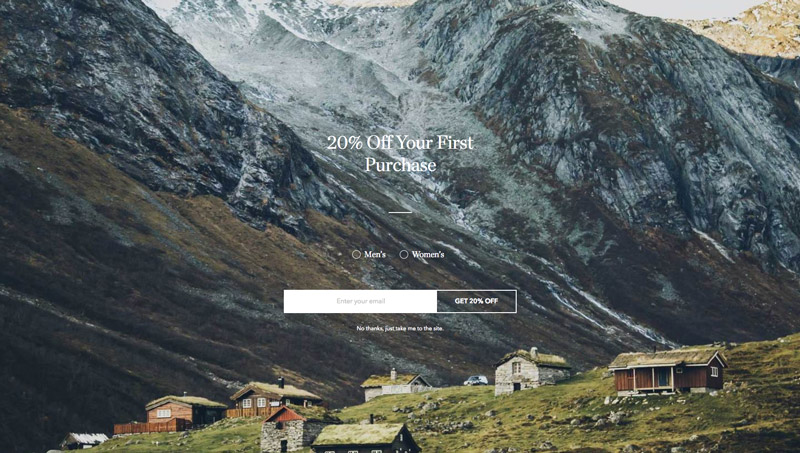
Though you could offer this coupon code immediately on the overlay, I’d recommend actually gating your code with a form asking for visitor emails. Though this might slightly reduce your initial conversion rate, it may actually increase sales over time based on your ability to convert leads through your email marketing efforts.
2. Recapture leaving customers with an exit-intent popup
With any luck, and a bit of analytics know-how, you’ll know how the various pages in your ecommerce funnel are converting. Depending on your product, pricing, and shipping costs, you should be able to identify the points in your funnel at which a large portion of your potential customers drop off and bounce.
For many businesses, this is the cart, shipping, or checkout stage. Getting the final cost of an item (including shipping, which can often be exorbitant) is often the stage at which customers decide whether or not to purchase. Chances are, customers leave more often than you’d like them to.
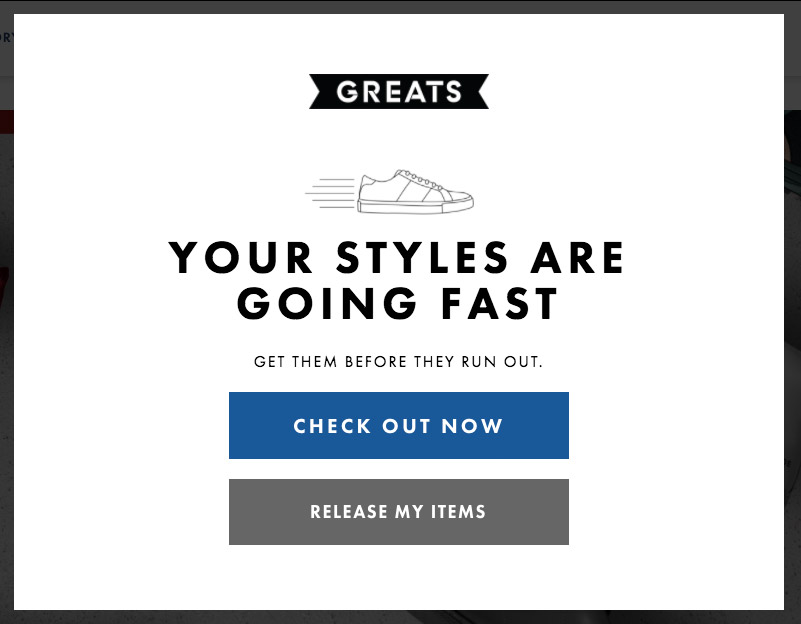
Combat this with an offer that you display to people who show exit-intent at the drop-off point within your funnel.
This offer could be anything including a discount or even free shipping – identify the pain points in your purchasing process, and try to iron them out with specific offers or discounts. Or do what bag company SoYoung did, and link people to a contest:
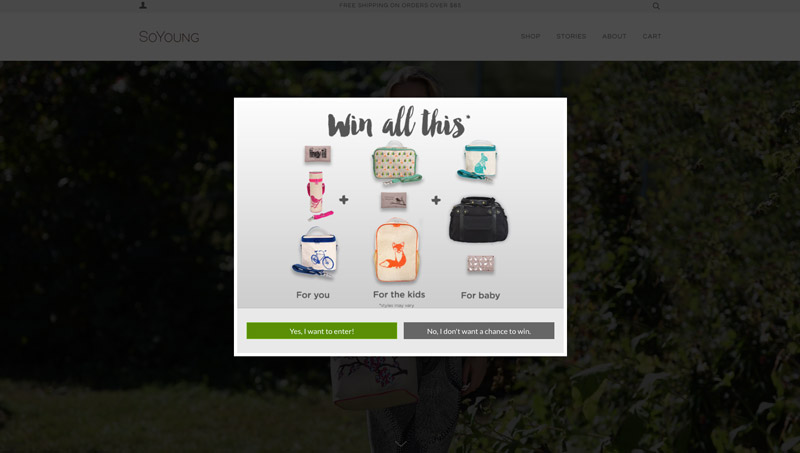
If you’re not confident visitors will close the popup and continue what they were doing, try asking for their email instead so you can follow up in the future.
3. Optimize your checkout process
It’s easy to get caught up on the more front-facing portions of our ecommerce site, like product pages. Unfortunately, focusing on these prettier pages often results in us to forgetting other equally (or even more important) things like our checkout page.
Though your checkout page probably doesn’t receive nearly the same amount of traffic that your product pages do, people who visit this page are incredibly important because they’re a single step away from converting and becoming customers.
In fact, almost a quarter of all ecommerce site abandonments are blamed on a complicated checkout process:

Though there are an endless number of ways you can optimize your checkout page to maximize its conversion rate, there’s one change you can make that will immediately bring results: reducing the number of form fields on your page.
It’s a simple, relatively underwhelming change, but it can have a massive impact on your bottom-of-funnel success.
Let me explain how and why it works…
Any time a visitor is asked to take an action, you naturally introduce a point of friction. As consumers, we can be pretty lazy, meaning any action we’re required to take often reduces our willingness to convert. This effect is compounded when the action we’re taking is providing personal information.
It’s a given that, in ecommerce, your customers will need to give you their name and address.
But try to minimize the things you ask beyond that – unless you’ve got a good reason for having them, things like “Where did you hear about us?” and “What kinds of products are you interested in?” will just increase friction.
Keep in mind that you can gather a ton of information on your customers through their actions (as opposed to collecting it through forms) – things like their buying preferences, apparel sizing, interests, and more. Use your lead tracking platform of choice to identify and segment customers as you see fit.
4. Build your list with an entry popup
In our ecommerce articles, we talk pretty often about how crucial it is for you to build your email list. You can’t often rely on a first-time visitor to convert, but a subscriber? Much more likely.
One simple way to turn visitors into mailing list subscribers is by using a list-building tool to add an entry popup to your ecommerce store that prompts people to sign up for your list, without detracting much from user experience.
Keep your entry popup simple – the ask itself is rather straightforward, so you don’t want to bog your popup down by adding a ton of unnecessary content. I’d recommend you use a standard popup, a slide-in popup or an opt-in bar for this.
Here’s a great example of a list-building popup:

And a few quick tips for building a great one:
- Keep copy short: No need to write a novel in your popup. Get straight to the point and highlight your offer, whether that’s it’s latest discounts and promotions, notifications about your upcoming products, or a discount on a purchase.
- Use bold colors: Using a bright color on your popup will help you catch a visitor’s attention. Keep your popup on-brand by choosing your one of your brand colors or a color that’s complementary to it.
- Use a single form field: The point of this popup is to collect a person’s email, and not much more. Don’t ruin your conversion rate by asking for things like name or interest here – save that for later steps in your funnel.

Bonus tip: Skip account creation for subscribers
By collecting a visitor’s email early on in their visit, you can save them time (and reduce friction) when they reach the lower stages in your funnel.
If you’re successful in collecting a visitor’s email through your popup, you won’t need to worry about creating an account for them once they’re ready to check out, since their email is already a part of your database.
5. Inform visitors of a sale by using an opt-in bar
As a savvy ecommerce store owner, you’re likely very familiar with running a sale. You know how to update product pages, create a sales category page, and send an email to your subscribers to let them know of the awesome deals you’re offering on your ecommerce store.
But we can do more.
One invaluable tool for any ecommerce store is the opt-in bar. An opt-in bar lives at the top (or bottom) of your page, and sticks to a visitor’s browser as you scroll.

Inform website visitors of a sale by adding an opt-in bar that links to your sale page. Add it to your entire website so any visitors from any traffic source (whether that’s organic, social media, or ads) know what’s going on with your store.
Here’s a few design tips for your opt-in bar:
- Minimize copy: I know I said this earlier, but it’s particularly important for your opt-in bar. For me, a general rule is if your copy takes up more than one line, it’s probably too long. Make it clear what your sale is about – for example, “Get 30% off all men’s clothing!”
- Make it narrow: Don’t treat your opt-in bar like an ad – it isn’t one. Remember that your opt-in bar will stick to a user’s browser, taking up precious screen real estate. When designing your opt-in bar, make it relatively narrow so it’s not obtrusive and won’t take away from people who are actually trying to shop on your website.
- Make your CTA clear: In this use case, I’d opt for a CTA like “SHOP SALE”. This makes it clear to a visitor that they’re not going to need to input their email for a coupon or sign up for some sort of discount – they’re going to go straight to the sale section of your site. While you’re at it, make the CTA a contrasting color to maximize click rate.

Of course, you can modify this tip to let customers know about any promotions you might have, including free shipping or a new product launch. I’d recommend slightly changing the design of your opt-in bar each time you update it, so it doesn’t become “white noise” to a frequent visitor.
6. Segment your list based on product page views
One of the most valuable uses for marketing automation is for segmentation. Segmentation is an invaluable tool when it comes to ecommerce, as it allows you to better focus and personalize your email marketing communications to maximize their effectiveness.
After all, there’s nothing worse than getting an email that seems like it was written with somebody else in mind.
You can set up your segmentation in a few different ways. You could go the traditional route and let people self-segment with a field in your signup form, but I’m of the opinion that it’s a little old-fashioned.
Put your marketing automation platform to work and create a workflow that segments people into lists based on the activities they’ve taken. For example, if I was a clothing store selling both men’s and women’s apparel, I might segment a lead based on their first product page visit (e.g. a men’s shirt vs. a women’s shirt).
Collecting this information allows you to personalize your email marketing when you send out newsletters – you might have, for example, a male mailing list and a female mailing list.
In addition to this, you can continue to personalize communications based on the emails they open, any new products they show interest in, or any purchases they make. The possibilities are endless!
Though it might take some time to set up at first, getting comfortable with using marketing automation to set up segmentation will pay off exponentially in the long term.
7. Automatically email people who don’t complete their purchase
As an ecommerce store owner, there’s little more frustrating than having someone follow your funnel all the way to the cart, and then leave soon after.
If only there was some way to get these customers back so they could finish making their purchase…
Enter the cart abandonment email.
Using the lead information you’ve collected from your almost-customers in combination with your marketing automation platform of choice, you can send an email to people who have added items to their cart but haven’t yet checked out.
Here’s an example of what the aforementioned email might look like:

As you can see, the email is a direct follow-up – it reminds the customer that they’ve left items in their cart. Using merge tags, it’s simple to add the name, image and information of the item to an email, which makes it a little more personal.
As far as copy goes, I’d say something like the following…
Hey {{first_name}},
It looks like you left a few items in your cart!
[Item Name/Image/Information]
Come back and check out and receive 10% off your entire order for the next 48 hours.
Best,
[Your Name]
If you’re feeling daring, offer free shipping or a discount as an incentive for your would-be customers to return to your site and complete their purchases.
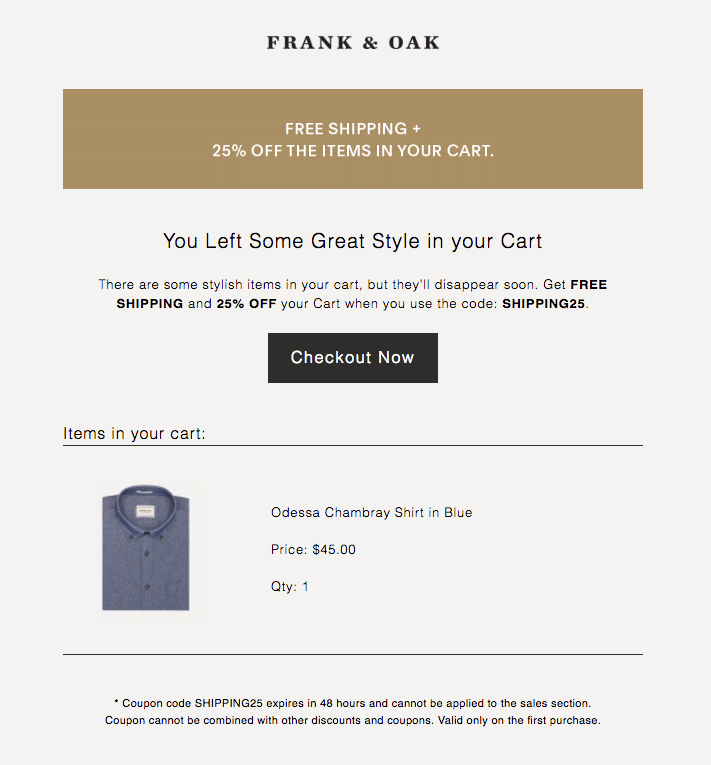
Wrapping it up
Hopefully, these tips will help you maximize the conversion rate of your ecommerce store. There’s always ways to improve your store’s success, so continue to experiment with new ideas.
Tried any of these tips? Have any tips to add? Let me know in the comments down below!
Related Reading:
- 30 Reliable Ecommerce Marketing Strategies (With Real-World Examples)
- The Ecommerce Guide to Online Marketing: How to Drive Traffic, Get More Sales, and Keep your Customers Coming Back
- Ecommerce Optimization: Smart Website Additions Guaranteed to Boost Sales
- Ecommerce Email Marketing: 7 Examples & Strategies to Drive Sales
- A Step-by-Step Walkthrough of a Complete B2C Marketing Campaign
- How to Create a Marketing Campaign (That Actually Drives Sales)


